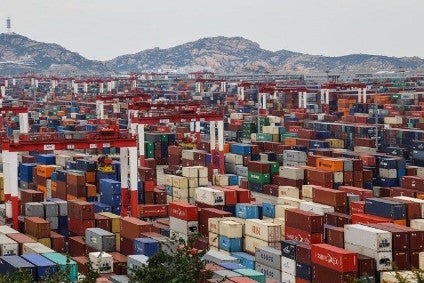
After a difficult Q2, trade activity in the apparel industry bounced back 14% in the third quarter, according to a new analysis of orders placed and invoices processed during the period.
A release of pent-up demand triggered a 26% surge in apparel order volume in July before falling back in August (-6%) and rising again in September (+21%). The data is based on business-to-business transactions across the Tradeshift platform, which is used by over 1.5m buyers and suppliers across all industries.
The latest Index of Global Trade Health shows the total number of purchase orders and invoices exchanged across global supply chains rose by 15% in Q3 after falling by a similar margin in Q2.
The report also suggests activity levels in major supply chain hubs in the West and China are beginning to stabilise after a tumultuous period.
Transactions in the Eurozone grew by the greatest margin, up 26% in Q3 as supply chains in the region added further momentum to the recovery seen towards the end of Q2. Trade activity between buyers and suppliers in the US also exceeded the global average, growing by 17% in Q3.
In the UK, where trade activity levels had dropped by 23% in Q2, the bounce-back in transaction volumes during the third quarter was much weaker. After a relatively strong July, a significant drop off in activity during August and September meant that UK supply chain activity finished the quarter just 6.1% up on Q2.

US Tariffs are shifting - will you react or anticipate?
Don’t let policy changes catch you off guard. Stay proactive with real-time data and expert analysis.
By GlobalDataActivity slows as pent-up demand recedes
Other regions also showed signs of a similar slowdown, suggesting the release of pent-up demand after lockdown restrictions eased in the West may have fuelled the early burst of activity across supply chains in July.
Transactions surged 24% in July. But month on month activity subsequently fell by 12% in August, before recovering slightly in September.
In China, activity levels looked on course to reach a level not seen since Q4 2019 in July. By September however, total transactions across the region’s supply chains had fallen by more than 18%.
“Global lockdown restrictions created a pressure cooker environment for supply chains,” explains Christian Lanng, CEO of Tradeshift.
“When the restrictions began to ease, we saw orders start to surge in June. This momentum continued into July before tailing off rapidly as supply lines normalised.
“Order volumes on our platform are comfortably ahead of where they were in Q2, but supply chains will need to hit a higher gear again in Q4 before we can point to a sustainable recovery. The next few months will be critical.”
Liquidity crunch puts supplier livelihoods at risk
A 20% rise in order volumes during Q3 should provide a welcome cashflow boost to suppliers towards the end of the year. But according to Tradeshift, action may be needed before then to address the current liquidity crisis affecting suppliers.
A record fall in order volumes during Q2 meant invoice settlements remained low throughout the quarter. With the average small business having just 27 days of cash in reserve, many will be coming dangerously close to running out of money.
“Lack of digitisation in global supply chains makes it very hard to unlock the liquidity that’s owed to suppliers,” Lanng adds.
“So instead of getting paid quickly, suppliers have to wait months before orders translate into cash. We should start to see some of the current liquidity pressure begin to ease in Q4.
Whether or not every supplier will make it that far is another question. If ever there was a time to rip up the old playbook and start doing things differently, it is now.”



